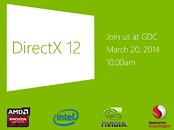I think it'd be good to point out what DX version NVIDIA supports as well? To me the sentence hints at either they do or don't support 11.2. That's just my opinion though.
GTX Titan Black supports the D3D11.2 API. Probably for the soul purpose of selling a cheaper Graphic Accelerator/Gaming Cards that didn't need the full 12 GB frame-buffer like the K40 Tesla. Anything before that doesn't support it. If you ask me, NVidia was hesitant to pay royalties for it in the GTX 780 Ti and it's predecessors. AMD's 7000 Series has had support on a hardware level for both D3D11.1 and 11.2. It eventually had full support from the software side through a driver update with the Win8 OS. NVidia mainly had support on a software level, but not the hardware level. Sadly, this is what you pay for your "premium price" in the past year with NVidia.
I'd argue that it was Microsoft's and Sony's console divisions that are responsible for this. Mantle was only officially announced about 6 months ago. Maybe Microsoft's DirectX people increased its development pace due to it, but it's hard to argue that this is a direct reaction to AMD. It likely has more to do with a way to differentiate PCs from video game consoles that finally are on feature parity with DirectX 11.
One, sounds to me like you wouldn't give AMD any credit for trying, and two pushing D3D12.0 now, or in a few years, won't force developers to suddenly shell out extra captia to upgrade tools to produce D3D12.0 Titles. Especially, it's not going to happen over night with the current situation in the US Economy--just looking at it in a situation where the US is the only ones developing future games that uses the new API, and people aren't being encouraged to invest in tomorrow's future. That being said, the most likely case would be the Consoles will have a shelf life of 5 to 7 years using DX11.2. MS and Sony will milk the situation with the consoles. After that, DX12.0 will probably emerge followed by DX12.1 and DX12.2. Unless DX12.0 is MS's attempt to be in competition with AMD Mantle because they have something to fear--I highly doubt it seeing as how AMD isn't pushing non-beta version of Mantle with great haste. I think this is probably MS's way of future-proofing the next generation of gaming for more revenue returns in 5 to 10 years. Making an announcement that MS is producing said API version. In addition, maybe this is MS's attempt to increase the value of MS Stock. Realistically, this is to give NVidia and AMD some time to see how to code with the new API before they actually start paying royalties to MS.
Sony will milk the console situation, but on the side, they will continue to push out 4K TVs, and may even provide some competition with Oculus Rift on the VR spectrum of the market. I know Sony will have a refresh version of it's VR headset. It will probably be released in a few months besides 4k TVs at 60p versus the current 30p. Competition will escalate when Oculus Rift starts coming out with non-developer version of their VR headset, and maybe even 4K versions of it. You know since Sony is the main company that's pushing 4K TV, they will eventually push a 4K VR headset when they can refine it... Sony's VR headset does 1080p, 24p true. For $1,000 a pop, it's not bad. I happen to have one, and even though it doesn't have head tracking like the Oculus Rift Developer's version, picture quality and fluidity is worth the premium price. Played some Planetside 2 with. It's pretty sweet, but it would be nice to have head-motion tracking in it when I am flying a VS Scythe. Oculus Rift will probably get even more popular when Star Citizens is released in 2015. Sony will probably invest in that area in some way.
MS will most likely talk about D3D12.0, and push refresh of all it's other, new, revised products (Office, Access, Visio, etc...). Since XBone seems to have issues over the PS4, this is probably MS's way of mis-directing attention away from XBone's performance on the market.
They only support DX 11.0, which makes me wonder they knew about DX12 long ago and the the plan was always to skip the point releases and dedicate resources toward DX12.
If NVidia knew about it, AMD probably knews about it too... If Intel continuous venturing in to the SOC market, they probably knew about it too... AMD has been pushing for DX11.1 and 11.2 APIs in two generations... In addition, they've been pushing DP and mini-DP usage besides the HDMI and DVI outlets. All your old 600 series NVidia cards weren't using DP. NVidia is now using Directcompute in it's 700 series Cards. A feature that's been known in the AMD cards for the past few generations.








 While our console peasants will be stuck at 1080p (or 900p/720p for xbone
While our console peasants will be stuck at 1080p (or 900p/720p for xbone  ).
).